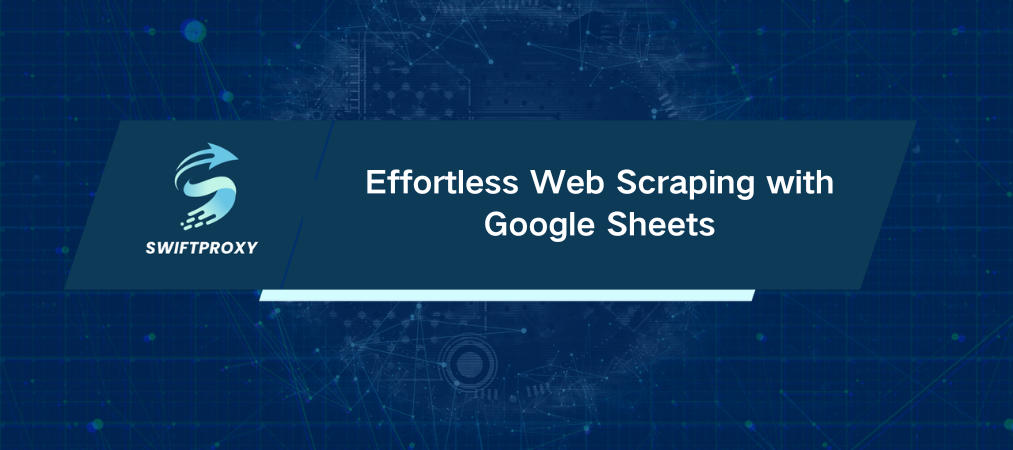Effortless Web Scraping with Google Sheets

If you want to track real-time data like product prices or monitor competitors without diving deep into complex coding, Google Sheets might be the solution. It's a free, easy-to-use tool that helps millions manage data, collaborate, and streamline tasks. Additionally, it can be used to scrape data from websites. With just a few formulas, you can gather valuable insights without writing any code.
In this guide, we'll walk you through how to harness the power of Google Sheets for web scraping. We'll cover essential functions, troubleshoot common errors, and share tips that will make the process smoother and more efficient.
Why Google Sheets for Web Scraping
Google Sheets is an unconventional choice for web scraping, and it's easy to see why. While most people turn to programming languages and specialized libraries for scraping, Sheets provides an intuitive, no-code alternative. If you need to collect specific data without getting bogged down by complex tools, Google Sheets is a time-saving, user-friendly option.
Plus, Google Sheets integrates seamlessly with the entire Google ecosystem: Gmail, Google Drive, Calendar – the works. With just one account, you can store, share, and manage your data effortlessly. Forget about worrying over lost work. Everything you do is auto-saved and accessible anywhere, anytime.
Key Functions to Use for Web Scraping in Google Sheets
Let's dive into the top functions that will transform your Google Sheets into a web scraping powerhouse. These functions are designed to import data from websites quickly, saving you the hassle of copying and pasting manually.
1. IMPORTXML: Extract Data Like a Pro
If you need to extract structured data from web pages, IMPORTXML is your go-to function. Whether you're after headlines, images, or stock prices, this function pulls the information directly from HTML, XML, and even RSS feeds.
Here’s the formula breakdown:
=IMPORTXML("URL", "xpath_query")
For example, if you want to pull Apple’s stock price from Google Finance, you’ll need the URL and the XPath query that points to the stock price element. Here’s how the formula looks:
=IMPORTXML("https://www.google.com/finance/quote/AAPL:NASDAQ", "/html/body/c-wiz[2]/div/div[4]")
To find the XPath, right-click the data you want to scrape, select "Inspect," and copy the XPath from the "Elements" tab.
2. IMPORTHTML: Pull Tables and Lists Without Breaking a Sweat
Say you need a list of UK cities or the latest sports scores. IMPORTHTML can scrape data from tables and lists directly into your sheet.
Here's the formula structure:
=IMPORTHTML("URL", "query", index)
For example, to pull a list of cities in the UK from Wikipedia, you can use:
=IMPORTHTML("https://en.wikipedia.org/wiki/List_of_cities_in_the_United_Kingdom", "table", 1)
Just find the page, identify the table or list you need, and Google Sheets does the rest.
3. IMPORTDATA: Quick and Easy CSV/TSV Import
Got a CSV or TSV file you need in Google Sheets? IMPORTDATA imports these files directly via their URL. Simple as that.
=IMPORTDATA("URL")
Perfect for importing statistical data or any structured dataset stored in CSV or TSV formats.
4. IMPORTFEED: Get RSS & Atom Feeds in Your Sheets
Want to track the latest headlines or updates from your favorite blogs? Use IMPORTFEED to bring RSS and Atom feed data into your sheet.
Here's the formula:
=IMPORTFEED("URL", [query], [headers], [num_items])
For example, to pull Wikipedia’s recent changes, use this:
=IMPORTFEED("https://en.wikipedia.org/wiki/Special:RecentChanges")
It’s a simple way to stay up-to-date with live content.
5. IMPORTRANGE: Link Data Across Sheets
IMPORTRANGE lets you pull data from one Google Sheet into another. It's especially handy when working with multiple sheets or collaborating with a team.
The formula looks like this:
=IMPORTRANGE("spreadsheet_url", "range")
Want to move data from one sheet to another? Just paste the URL and specify the range.
Troubleshooting Common Errors
Nothing's more frustrating than an error message when you're in the middle of scraping. Here are some common mistakes and how to fix them:
· #N/A: The value you're trying to pull doesn't exist.
· #REF!: You're referencing a cell that no longer exists. Check if any rows or columns were deleted.
· Result Too Large: You're trying to import more data than Google Sheets can handle. Try limiting the amount of data.
· #VALUE!: This usually means there's a data type mismatch (e.g., text when a number is expected).
Watch Out for Google Sheets' Limitations
While Google Sheets is powerful, it does have some limitations. Your sheet can only contain up to 10 million cells, and large datasets or complex functions (like IMPORTXML) can slow things down. It's best suited for smaller-scale scraping.
Also, Google Sheets struggles with dynamic content loaded by JavaScript, and it has rate limits to prevent overloading its servers. So, if you're scraping massive amounts of data or content that requires interaction (like clicking buttons), Sheets may not be the best tool.
When to Use Proxies
If you're hitting the rate limits or encountering blocks, proxies can help. They allow you to route requests through different IPs, reducing the chances of getting blocked. For larger scraping projects, combining Google Sheets with proxies can boost your efficiency and keep things running smoothly.
When Google Sheets Won't Cut It
For large-scale scraping or sites with strong anti-bot measures, it might be time to look beyond Google Sheets. Tools like Octoparse, Scrapy, or Beautiful Soup are better suited for heavy-duty scraping tasks. These offer more customization and handle dynamic websites better, though they may require some technical know-how.
If you're using proxies, be sure to use them in combination with these scrapers for optimal performance.
Final Thoughts
Google Sheets can be an effective tool for scraping data, especially for smaller projects or static content. With the right functions and some knowledge, you can automate data collection without complex coding. However, for more advanced needs, specialized tools designed for large-scale scraping are available. Choose the best option for your project, and with Google Sheets, simplicity is just a formula away.

















































